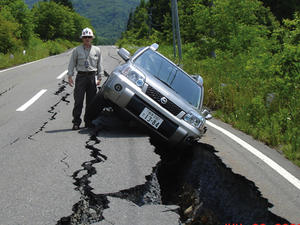DisastersMore American civil engineers deployed to Japan to study damage
Last week the American Society of Civil Engineers (ASCE) deployed two more disaster assessment teams to Japan to study the damage wrought by the 11 March earthquake and tsunami; the two teams, the third and fourth deployed by ASCE, will tour the damaged areas which include the approximately 292 square miles inundated by the tsunami; one team will focus on examining the effects that the tsunami and earthquake had on port structures; the other team will focus their efforts on investigating the impact of the earthquake and tsunami on coastal structures like tsunami walls, breakwaters, and seawalls

Civil engineer Brady Cox inspecting quake damage in Japan // Source: uark.edu
Last week the American Society of Civil Engineers (ASCE) deployed two more disaster assessment teams to Japan to study the damage wrought by the 11 March earthquake and tsunami.
The two teams, the third and fourth deployed by ASCE, will tour the damaged areas which include the approximately 292 square miles inundated by the tsunami.
One team will focus on examining the effects that the tsunami and earthquake had on port structures. Satellite images clearly show damaged equipment and cargo, but the port structures themselves seem relatively unscathed. The team will examine the buildings more closely to see how they fared.
The other team will focus their efforts on investigating the impact of the earthquake and tsunami on coastal structures like tsunami walls, breakwaters, and seawalls.
The lessons learned from their exploration of Japan’s damaged structures will help ASCE as it amends the ASCE7 standard, which determines building codes for structures in the United States.
In particular, the knowledge gained by ASCE teams will help engineers design coastal building standards that can withstand tsunami wave conditions. Currently, all coastal flood minimum design standards for buildings and other structures are based on hurricane conditions and have not been tested against tsunamis.
The west coast of the United States is vulnerable to tsunamis and according to the Oregon Department of Geology and Mineral Industries, the area stretching from Northern California to Washington closely mirrors Japan’s northeastern coast, the area hardest hit by the tsunami.
The area, known as the Cascadia Subduction Zone, is prone to earthquakes and could generate a tsunami that would affect coastlines in Washington, Oregon, and Northern California.
Lessons learned by ASCE teams will be particularly valuable for Alaska, Hawaii, and western states in the United States as U.S building codes there and Japanese codes share many similarities. In addition the geographical distribution of heavily populated centers along Japan’s northeastern coast is similar to cities on the U.S. west coast.
The ASCE teams will frequently post updates on their findings on ASCE’s website.
